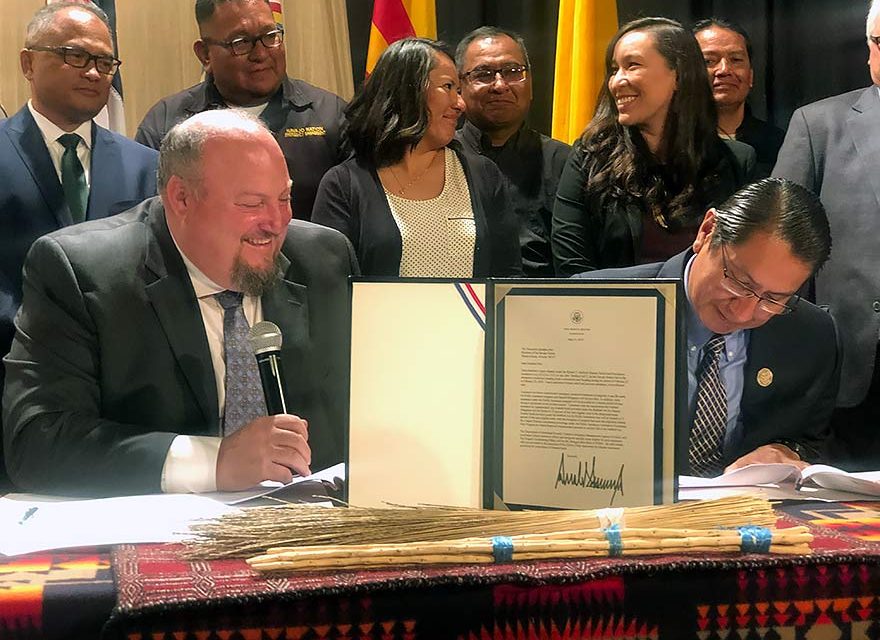
Nation to be reimbursed for storm expenses

Navajo Times/Arlyssa Becenti
Robert J. Fenton, FEMA Region 9, and Navajo Nation President Jonathan Nez, sign FEMA-Tribe Agreement, June 10 at the Navajo Nation Museum, to secure reimbursement of emergency funds expended during the severe snowstorms this past February.
WINDOW ROCK
The total expended to prepare for the severe snowstorms that hit Navajo in February tallied to about $570,000, and the Navajo Nation is due to be reimbursed.
Although this total is only an estimate, and the exact amount has yet to be determined, it’s clear the expended funds surpassed the Federal Emergency Management Agency’s reimbursement threshold of $250,000, and last month President Donald Trump granted a Major Disaster Declaration for the Navajo Nation, which frees up those funds.
On Monday, Robert J. Fenton of FEMA Region 9, and Navajo President Jonathan Nez signed an agreement for FEMA to respond to the major disaster. Fenton applauded the Navajo Nation’s preparedness before the storms touched the ground.
“If we are going to respond to disasters there really is nothing that we can do once disasters happen, other than send first responders to help,” said Fenton. “But if we want to change the outcome, it’s what we do prior to that. The preparedness they took on before this disaster… is important in being able to respond effectively.”
Fenton said Region 9 is one of the largest and most diverse FEMA regions, comprising Nevada, California, Arizona, Hawaii, and the Pacific Islands. Over the last two years FEMA has had to respond to 36 major disaster declarations.
“We’ve had all different types of events from volcanoes, floods, snowstorms, hurricanes, cyclones, typhoons,” said Fenton. “This year alone we’ve had five different declarations from five different Native tribes.”
This year’s abundance of moisture is a blessing and also a concern, said Nez, referring to the overflowing San Juan River. Last year, when the almost complete lack of rain and snow was a concern, he said many prayers were sent for more moisture and those prayers were heard.
When the declaration of emergency was made in February, there were up to two feet of snow on parts of the Navajo Nation.
“We prayed for moisture but we didn’t ask for the amount,” said Nez. “But we’re blessed with a lot of snow and rain. The San Juan River is in the flood stage right now … With that blessing you have to expend resources, and that’s what happened with the snowstorm.”
Nez acknowledged all the programs, departments and chapters who contributed in being proactive. He said he was only a facilitator when it came to the daily updates, and the real work came from the programs and chapters.
He noted that when the National Weather Services predicted a heavy snowfall the Nation granted administrative leave; an extra day off was given for people to help elders who may have needed assistance.
“This was a great partnership,” said Nez. “This may be a model to replicate. We did administrative leave, but you worked and were out there preparing to help your elders.”
The monies that will be refunded came mostly from local chapters that had expended their own resources to assist their community members, Nez said. He added that this is an example of “re-teaching self-sufficiency, self-determination, self-government to our people.”
Doug Watchman, emergency services liaison for Navajo Emergency Management, said this was the first time that FEMA had ever ventured out to Navajo to participate in a signing such as this one.
During the entire time in which the command center was operating Watchman played a pivotal role working as the emergency operations manager.
Watchman said they are still collecting cost summary sheets from chapters that have yet to submit theirs, so the total to be reimbursed could easily increase.
“I think we were so expatiate in getting this declaration up and running through the process,” said Watchman as to why a FEMA representative actually came out for this signing.
“Most times it would take three to four years before reimbursement would come in. The efforts of the whole emergency management team and working with chapters, stakeholders, and partners, was how we were able to push this forward and got this reimbursement,” he said.
To read the full article, pick up your copy of the Navajo Times at your nearest newsstand Thursday mornings!
Are you a digital subscriber? Read the most recent three weeks of stories by logging in to your online account.








 Highway 264,
Highway 264, I-40, WB @ Winslow
I-40, WB @ Winslow